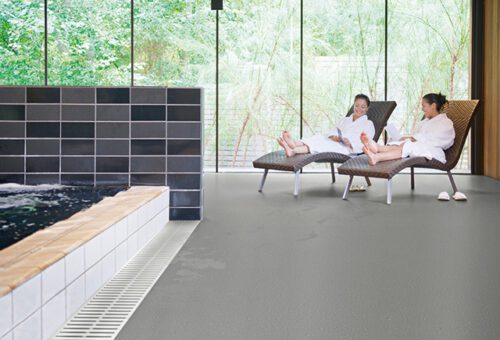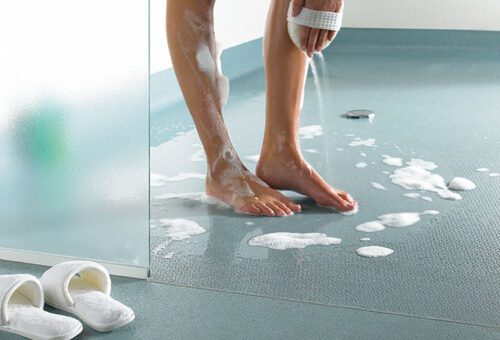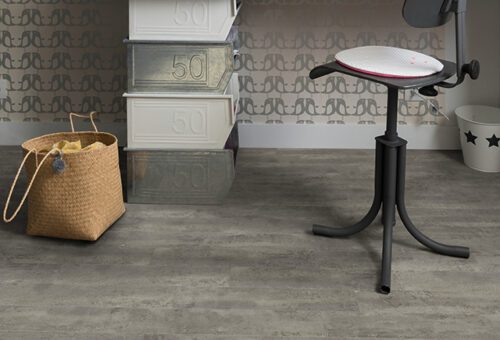Restoration Guide for Vinyl Flooring
Afloor offers a selection of commercial sheet vinyl flooring, which provide a safe and sustainable solution to preventing slips, trips and falls from occurring. Our safety flooring is ideal for high-risk commercial environments including schools, retail kitchens and bathrooms.
All of our safety flooring products are manufactured by the most reputable brands on the market, including Polyflor and Tarkett. They come in a range of styles and designs to suit all kinds of interiors. Discover what sheet vinyl flooring solutions we have to offer.
This restoration guide for vinyl flooring will run you through the basics and answer all of your burning questions associated with vinyl flooring restoration before offering you tips and tricks when it comes to vinyl flooring maintenance.

Vinyl Sheet Flooring Frequently Asked Questions
What is vinyl flooring?
Vinyl flooring is a large, continuous roll of vinyl floor covering that is completely impermeable to water. Whereas LVT comes in tiles and vinyl interlocking planks like so.
Vinyl sheet flooring comes in many colours and styles, from playful designs to popular wood grains. They are one of the most affordable floor coverings on the market and have low VOC emissions, contributing to a healthier indoor environment.
Is vinyl flooring better than laminate flooring?
To understand which flooring type is better for your project, you first need to understand the difference. Whilst vinyl sheet flooring is one continuous roll containing a PVC plastic core bonded to either a felt or foam backing, which is topped with a printed design layer and an added tough transparent wear layer. Whereas laminate floors are a hybrid covering consisting of a particleboard wood base, topped with an image layer and a transparent wear layer. Laminate comes in planks which must be fitted together.
You might be wondering about the major differences between these two floorings. Aside from the structure of the two, there are some similar qualities and also many pros and cons to either option. Equally easy to install, cost-effective and attractive contributions to your rooms, here are the main pros and cons that actually differentiate the two.
What are vinyl flooring pros?
- Vinyl flooring is water resistant due to the material its made from creating a continual seal against the subfloor
- It is perfect for high-traffic areas such as bathrooms and kitchens thanks to its durability
- It’s easy to install vinyl flooring, meaning a quicker turnaround on your new project
- It’s easy to maintain, however this doesn’t mean you can neglect it, proper upkeep will have it looking fresher for longer
- When cared for properly, it can last up to ten or twenty years
- It comes in many designs from wood-style grains to playful designs
- It’s one of the most affordable options on the market
- It’s comfortable underfoot. So despite looking like wood or stone flooring, you benefit from a softer experience to walk on
- It’s suitable for underfloor heating, depending on the conditions
What are vinyl flooring cons?
- Although it’s durable, it can damage easily. From a dropped knife to dragged furniture, be sure to add coasters to any furniture legs to have it last longer. If you do have any accidents, we’ve got some tips later in this restoration guide
- The quality of the colours can fade over time if placed in direct sunlight. Try keeping any vinyl flooring shaded by curtains or blinds on particularly sunny days
- Since vinyl flooring is made from plastic, the material is not biodegradable
What are laminate flooring pros?
- Like vinyl flooring, it’s highly durable and it’s easy to maintain
- It’s an affordable alternative to solid or engineered wood
- Installation of laminate flooring is simple for DIY projects
- It’s available in an array of colours and styles
- It has an average lifespan of 15-25 years
- It’s suitable in all rooms of the home, including furniture presence
- It’s suitable for underfloor heating
What are laminate flooring cons?
- Laminate can’t be refinished if experiencing damage
- It’s not as quiet as carpet, nor soft underfoot like vinyl flooring
- Laminate can be slippery, even without water

What rooms are suited to vinyl flooring?
Vinyl flooring is perfect for high-traffic areas of your home or commercial settings such as foyers, kitchens, bathrooms and more. Thanks to its durability, it can withstand a lot and is best suited to bathrooms, kitchens and hallway areas.
Can vinyl flooring be recycled?
Yes, although it is not biodegradable. Polyflor has its own vinyl takeback scheme so you can recycle your scraps or old vinyl flooring at these drop-off locations.
Can vinyl flooring be painted?
Yes, but only with the right materials. If you’re looking to revamp your space, use floor paint that’s made to withstand foot traffic. Applying two coats of primer and two coats of paint will help make the finish more impervious.
Is vinyl flooring waterproof?
Yes, vinyl flooring is waterproof. Vinyl flooring is water resistant due to the material it’s made from creating a continual seal against the subfloor and the materials it’s made from. A PVC plastic core bonded to either a felt or foam backing, which is topped with a printed design layer and an added tough transparent wear layer.
Is vinyl flooring scratch resistant?
Yes, vinyl flooring is a great scratch-resistant option, but you’ll need to be careful when moving heavy furniture around on it to avoid scraping the top coat.
When to replace vinyl flooring?
Depending on the quality of your new vinyl flooring, you can expect a good 10 years for low quality and 15-25 years with high-quality vinyl flooring and proper installation. Read on to find out how to repair damages and keep your vinyl flooring for longer.
How to Repair Sheet Vinyl Flooring
While vinyl flooring is surprisingly durable, it doesn’t last forever. It’s not uncommon to spot a rip, tear, or hole in the vinyl when you’re cleaning up. This can be a frustrating experience, but most vinyl floors can be easily repaired with a few simple tools.
Typical Causes of Damage to Vinyl Flooring
The most common cause of tears in your vinyl is dragging a heavy object with a pronounced point or sharp metal edge across the surface. This can include seemingly innocuous things like tables and chairs, rearranging furniture, dragging boxes of items away for storage, and so on. Dropping sharp objects such as knives can also cause minor damage.
How to Avoid Damaging Your Vinyl Flooring
When moving heavy items in a vinyl-floored area, be sure to lift those items rather than drag them along. Not only will this minimise the risk of damaging your floor, but it is also a much safer method of moving heavy items such as furniture. Even if you need help from a friend or loved one, you are less likely to injure yourself by lifting than you are by dragging.
For really heavy appliances like dishwashers and washing machines, you may have no choice but to drag the item into position. You can avoid damaging the floor by laying a plywood path from its start to end positions. Use this as a safe surface to drag your heavier items across, as the only damaged material will be the plywood.
How to Repair Minor Tears
Small rips and tears in your vinyl are easy to repair. You will need a hair dryer, some vinyl floor adhesive, and a pallet knife. Begin by moving the hair dryer gently over the area where the rip is most prominent. What you are trying to do here is melt the adhesive beneath without warping the vinyl, so take your time.
Once the vinyl can move a little, gently pry both sides of the tear away from the floor, taking care not to damage the vinyl itself. Apply some fresh adhesive to a pallet knife and slip it between the subfloor and the vinyl, using the knife to spread a layer of glue between them. You need to push both sides of the small tear together so that they form a joint.
With the two sides neatly aligned, you should weigh them down with a suitably heavy object. This will prevent the two sides of the rip from slipping away from one another while you wait for the adhesive to dry. This could be anything from a dumbbell weight to a full tin of paint.
How to Repair Larger Tears
If the tear is more than just a straight rip down the vinyl, the technique described above will not be sufficient. You will need to replace the torn part with some fresh vinyl. Using a utility knife, cut out the affected part of the tile in a neat square or rectangle.
Take a spare scrap and measure up the correct size to fill the gap. If the vinyl is patterned, be sure to make it align with the edge around the hole you have just cut out. Apply adhesive to the reverse side of the tile and the subfloor and carefully place in the piece.
Hold it in place for a few minutes for the adhesive to take effect. During this time, you will be able to make slight adjustments to its position to get it lined up correctly. Once you’re satisfied, put something heavy on top of the tile to hold it in place. It should be fine to walk on within 48 hours.

How to Replace a Vinyl Floor
If you want to replace the entire floor, you will need to pry up the old sheet first. The easiest way to do so is to pour hot water over the floor and leave it for about half an hour. This will melt the vinyl holding it in place, making it much simpler to remove.
Any remaining adhesive stuck to the subfloor can be removed with an appropriate solvent, or it can be left to dry and then sanded down. Once the subfloor is ready, you can start installing your new vinyl flooring. Follow our step-by-step guide for help with installing vinyl flooring.
Afloor offers a range of vinyl sheet flooring, suitable for both commercial and domestic use. Visit our online store today for the latest prices and availability, or call your local branch for tailored advice. We hope this restoration guide to vinyl flooring has answered all of your questions and if you need some top tips on how to clean vinyl floors we’ve got you covered. Or, learn how to install vinyl flooring properly for a fresh new project.
